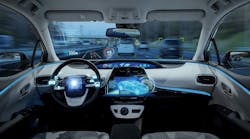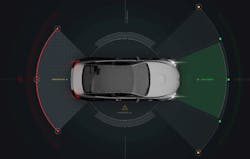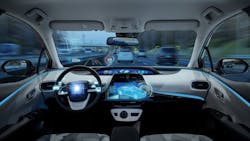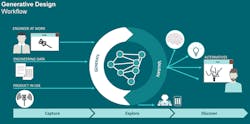The technological ramp to fully autonomous vehicles presents significant challenges for companies developing autonomous-vehicle (AV) programs. Advanced sensor technology, high-speed and high-bandwidth data networks, and cutting-edge artificial intelligence are all crucial to the functional and commercial success of AVs (Fig. 1). In addition, most estimates predict that AVs will require billions of miles worth of testing to ensure their safety. Manufacturers will need to incorporate the lessons learned through simulated and real-world testing into their AV designs to remain competitive.
1. Autonomous-vehicle platforms must connect an array of advanced sensors and computers through high-speed data networks to perceive, assess, and act on environmental stimuli.
The Society of Automotive Engineers (SAE) defines six levels of sophistication for autonomous vehicles, from zero to five. A car with level-two autonomy may feature active cruise control, a lane-departure warning system, lane keep assist, and parking assistance. In total, this car requires about 17 sensors to enable its driver-assistance systems.
The computations performed by such a car’s automated systems are relatively primitive. The lane-keep-assist system, for instance, is only tasked with monitoring the vehicle’s position relative to the lines of the road. Should the driver begin to stray, the system will notify the driver or take corrective action, but ultimate responsibility for control of the vehicle lies with the driver.
A level-five AV will have complete control over the driving task, requiring no human input. As a result, a level-five car is projected to have more than 30 additional sensors of a much wider variety to cover the immense number of tasks an autonomous vehicle will need to perform (Fig. 2). On top of the ultrasonic, surround camera, and long- and short-range radar sensors of a level-two car, level five will require long-range and stereo cameras, LiDAR, and dead-reckoning sensors. The increase in sensors will increase the amount of wiring needed in the harness and the necessary computational resources to handle the gigabits of data being produced by the sensors.
2. A fully autonomous vehicle will require many types of sensors to accurately perceive dynamic driving environments.
While designing a level-five platform, engineers will need to perform architecture and tradeoff analyses to investigate architectural proposals, such as a centralized vs. domain vs. distributed architecture. These analyses will need to account for hundreds of components and millions of signals while optimizing function locations, network latency, error rates, and more.
Despite these challenges, autonomous drive is a burgeoning market. At least 144 companies have announced AV programs. Some of these are major automotive manufacturers seeking to stay ahead of the coming industry disruption, but most are startups or companies from other industries seeking to enter a traditionally impenetrable market.
These companies lack industry-specific experience and the engineering resources to brute force their way through the complexities of autonomous vehicle design. Even the major automotive OEMs will face problems that their legacy design flows are ill-equipped to handle. To compete, these companies will need a new design methodology that enables young engineers to design accurate and optimized systems, which can only be done by capturing the experience and knowledge of veteran engineers. They will need generative design.
Generative Design and Engineering
Generative design takes system definitions and requirements as input and generates architectural proposals for the logic, software, hardware, and networks of the electrical and electronic systems using rules-based automation (Fig. 3). These rules capture the knowledge and experience of the veteran engineers to guide younger engineers throughout the design. Capturing this IP helps companies to develop both vehicle architectures and new generations of engineers as they learn and implement existing company knowledge.
3. Generative design uses rules-based automation to generate proposals for the logic, software, hardware, and networks of the electrical and electronic (E/E) system.
The increasing electrical and electronic content of modern vehicles is already pushing current design methods to their limits, yet the complexity of automotive systems will only continue to grow in the future. Autonomous cars will contain the most complicated electrical and electronic systems yet seen in the automotive industry.
For instance, more than 30 sensors, miles of wiring, and hundreds of ECUs will be required to gather, move, and process the data necessary for autonomous driving. The data networks will need to be extremely fast to support real-time perception, decision-making, and action to prevent collisions and harm to human passengers or pedestrians. Engineers developing these vehicles will also need to balance performance requirements against power consumption, physical space constraints, weight, and thermal considerations.
Generative design empowers automotive engineers to tackle the challenges of electrical and electronic systems design for autonomous vehicles. It employs rules-based automation for rapid design synthesis, enables engineers to design in the context of a full vehicle platform, and tightly integrates various design domains to ensure data continuity.
Firstly, employing automation throughout the process will help design teams manage design complexity without increasing time-to-market. Automation helps engineers focus on the most critical aspects of the design and verification of the functionality of the E/E system’s functionality and reduces errors from manual data entry. This empowers engineers to focus more of their time on applying their creativity and ingenuity to creating the next generation of automotive technology breakthroughs. Automation also applies company IP to the generated proposals through design rules, increasing the accuracy and quality of the designs.
Next, designing in the full platform context helps engineers to understand the way signals, wires, and other components are implemented across the entire vehicle platform, thereby reducing errors at interfaces or due to the intricacy of the harness. This design flow also enables teams to reuse validated data across vehicle platforms to improve quality and reduce development costs.
Finally, a tightly integrated environment enables the electrical engineers to share data with engineers and tools in other domains, such as mechanical or PCB design. The interactions between the electrical, mechanical, and software components of a vehicle are increasing. Seamless synchronization of data between these domains improves the integration of them into a single system.
Data Continuity
Generative design also creates a continuous thread of data from the initial system definition and requirements to full-scale production and service. The same data feeds each stage of the generative design flow so that nothing is lost between design stages or design domains. This continuous thread of data keeps all engineering team members up to date and working with the most current data while also ensuring that designs are meeting various requirements for functionality, safety, weight, and so forth (Fig. 4).
4. Generative design ensures data continuity from initial system definitions through production and after-sales for full traceability and compliance with requirements.
Data continuity ensures that projects have a single data source, providing a clear picture of the myriad inter-domain and inter-system interactions. Designs can be automatically checked against design rules to ensure their functionality, accuracy, and quality. As changes are made to the design, they can be examined with detailed impact analysis that will inform the engineer of issues the change may cause in other domains. For instance, moving or removing an ECU could be assessed for its impact on network timing, signal integrity, or physical clearance and collision issues. As a result, changes are made knowing their full impact on the system.
Enabling the Autonomous Drive Winners
Generative design will be a key enabler for new and established automotive companies in their pursuit of developing fully autonomous vehicles. The ability to generate electrical system architectures automatically enables early exploration and optimization of designs while embedding company IP into the design flow. In addition, a singular source of data promotes consistency between domains, design reuse, and enhances the analysis of change impact. Finally, tight integrations between the electrical domains and with mechanical and product lifecycle management tools streamlines the entire design flow from conception through production.
The massive complexity inherent in AV design will continue to push the tools and methodologies used by automotive engineers. This is especially true in the electrical and electronic systems domains as they come to dominate the operation of a vehicle’s safety-critical systems and amenities. The winners in this disruptive technology will be those companies that can most effectively integrate the advanced technologies required for autonomous drive into a package that’s reliable, safe, and attractive to consumers, and then get those technologies to market quickly and with a high level of quality.





